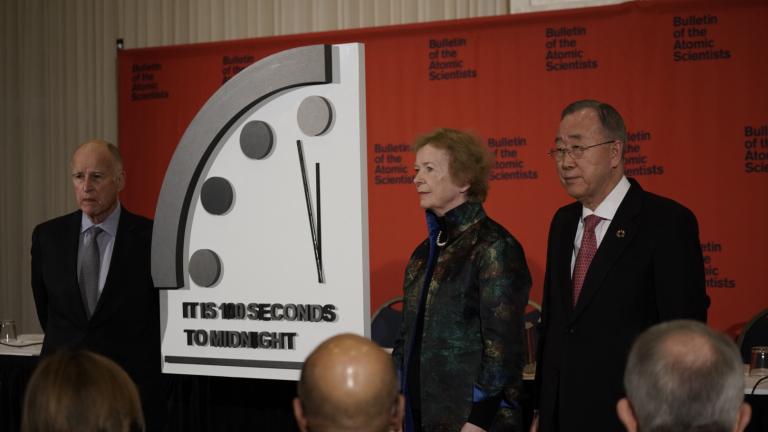File:100 seconds to midnight.jpg
100_seconds_to_midnight.jpg (768 × 432 pixels, file size: 30 KB, MIME type: image/jpeg)
100 Seconds: Much Too Close to Midnight
A dark nuclear landscape, with glimmers of hope
Bulletin of the Atomic Scientists / Editor’s note: Founded in 1945 by Albert Einstein and University of Chicago scientists who helped develop the first atomic weapons in the Manhattan Project, the Bulletin of the Atomic Scientists created the Doomsday Clock two years later, using the imagery of apocalypse (midnight) and the contemporary idiom of nuclear explosion (countdown to zero) to convey threats to humanity and the planet. The Doomsday Clock is set every year by the Bulletin’s Science and Security Board in consultation with its Board of Sponsors, which includes 13 Nobel laureates. The Clock has become a universally recognized indicator of the world’s vulnerability to catastrophe from nuclear weapons, climate change, and disruptive technologies in other domains.
To: Leaders and citizens of the world
Re: This is your COVID wake-up call: It is 100 seconds to midnight
Date: January 27, 2021
... Accelerating nuclear programs in multiple countries moved the world into less stable and manageable territory last year. Development of hypersonic glide vehicles, ballistic missile defenses, and weapons-delivery systems that can flexibly use conventional or nuclear warheads may raise the probability of miscalculation in times of tension. Events like the deadly assault earlier this month on the US Capitol renewed legitimate concerns about national leaders who have sole control of the use of nuclear weapons. Nuclear nations, however, have ignored or undermined practical and available diplomatic and security tools for managing nuclear risks. By our estimation, the potential for the world to stumble into nuclear war—an ever-present danger over the last 75 years—increased in 2020. An extremely dangerous global failure to address existential threats—what we called “the new abnormal” in 2019—tightened its grip in the nuclear realm in the past year, increasing the likelihood of catastrophe.
... As we noted in our last Doomsday Clock statement, the existential threats of nuclear weapons and climate change have intensified in recent years because of a threat multiplier: the continuing corruption of the information ecosphere on which democracy and public decision-making depend. Here, again, the COVID-19 pandemic is a wake-up call. False and misleading information disseminated over the internet—including misrepresentation of COVID-19’s seriousness, promotion of false cures, and politicization of low-cost protective measures such as face masks—created social chaos in many countries and led to unnecessary death. This wanton disregard for science and the large-scale embrace of conspiratorial nonsense—often driven by political figures and partisan media—undermined the ability of responsible national and global leaders to protect the security of their citizens. False conspiracy theories about a “stolen” presidential election led to rioting that resulted in the death of five people and the first hostile occupation of the US Capitol since 1814.
In 2020, online lying literally killed.
Considered by themselves, these negative events in the nuclear, climate change, and disinformation arenas might justify moving the clock closer to midnight.
... US and Russian nuclear modernization efforts continued to accelerate, and North Korea, China, India, and Pakistan pursued “improved” and larger nuclear forces. Some of these modernization programs are beginning to field weapons with dangerous enhancements, like Russia’s nuclear-tipped Avangard hypersonic glide vehicles, which are being installed on new SS-29 (Sarmat) missiles designed to replace 1980s-era intercontinental ballistic missiles (ICBMs). Russia continues to field battalions of intermediate-range, ground-launched, nuclear-armed missiles—missiles previously banned by the now-defunct Intermediate-range Nuclear Forces Treaty, from which the United States withdrew in 2019. China, which has historically relied on a small and constrained nuclear arsenal, is expanding its capabilities and deploying multiple, independently retargetable warheads on some of its ICBMs and will likely add more in the coming year.
We continue to believe that human beings can manage the dangers posed by modern technology, even in times of crisis. But if humanity is to avoid an existential catastrophe—one that would dwarf anything it has yet seen—national leaders must do a far better job of countering disinformation, heeding science, and cooperating to diminish global risks. Citizens around the world can and should organize and demand—through public protests, at ballot boxes, and in other creative ways—that their governments reorder their priorities and cooperate domestically and internationally to reduce the risk of nuclear war, climate change, and other global disasters, including pandemic disease.
We have experienced the consequences of inaction. It is time to respond.
~
File history
Click on a date/time to view the file as it appeared at that time.
| Date/Time | Thumbnail | Dimensions | User | Comment | |
|---|---|---|---|---|---|
| current | 16:43, 28 January 2021 |  | 768 × 432 (30 KB) | Siterunner (talk | contribs) |
You cannot overwrite this file.
File usage
- Anthropocene
- China
- Environmental Security
- Environmental Security, National Security
- Europe
- European Union
- Global Security
- Green Graphics
- Green Politics
- New Definitions of National Security
- Nuclear Free
- Nuclear Nonproliferation
- Nuclear Proliferation
- Nuclear Weapons
- Radioactive Pollution
- Radioactive Waste
- Russian Federation
- Strategic Demands
- Threat Multiplier
- US
- Whole Earth
